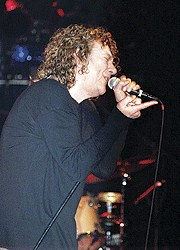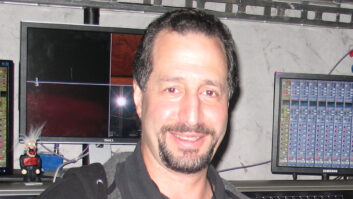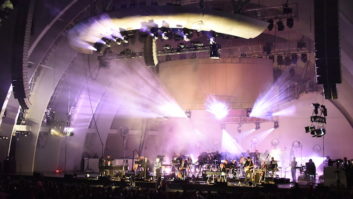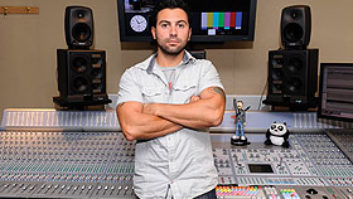
A name synonymous with rock ‘n’ roll for more than 35 years, you would expect a Robert Plant show to sound technically good. After all, who’s had more resources and access to the best skilled audio professionals in the world? As in the past, Plant’s performances were put in the hands of sound reinforcement masters with years of experience.
photo: Dave Vann
Thunder Audio (Taylor, Mich.) received the nod from the Plant organization based on the years of experience that company VP Paul Owen brings to the table. As a monitor engineer, Owen has spent 19 years with Metallica, as well as riding the monitor faders for AC/DC, Def Leppard, Tesla and many more. He’s known Plant’s front-of-house engineer, Roy Williams, for 25 years.
The live sound business is filled with big egos, but you won’t find a more reserved sound professional than Williams. Camera-shy and soft-spoken, he’s had a longtime friendship with Plant and was involved in bringing the right mix to concertgoers during the beginning of the Page/Plant reunion in the early ’90s.
Mix caught up with the tour at Meadowbrook Music Festival, a beautiful 7,500-person capacity shed tucked away in the woods at Oakland University in Auburn Hills, Mich., in early July. While the night brought seasonal Midwestern humidity and menacing thunderstorms, the sound crew maintained their focus on the task at hand: adjusting equalization using the Lake Technology Mesa software and tablet.

Thunder Audio VP Paul Owen; FOH engineer Roy Williams declined to be photoographed.
photo: Craig Dalton
TESTING THE VOCAL MIX
Running through his currently air-played “Shine It All Around” during soundcheck, the technically adept Plant makes suggestions on the vocal mix. “He likes to hear it coming back from the front, what the audience hears,” says Williams. “He’s very old-school; not afraid of technology at all, mind you. But look at the stage setup: It’s very tight so he can be in touch with the band at all times.”
Backing Plant is The Strange Sensation, a stellar group comprising old friends and new: John Baggott, Moogs/Wurlitzer pianos; Justin Adams, guitar; Billy Fuller, bass; Skin Tyson, guitar; and Clive Deamer, drums. There are a variety of instruments used during the show — lots of guitars, of course — including various rhythm and acoustic instruments; analog keyboards provided a true variety of sonic architecture in each song. With new versions of Led Zeppelin classics and the Celtic/Middle Eastern/pop/jazz/Zeppelin influences, there’s quite a challenge in keeping it all correctly mixed as the bandmembers frequently change instruments throughout the show.
Williams and Plant have a surprising approach to all of this. These days, where compression and gates are staples in controlling what happens where in the mix, Williams uses very little. “Most of the mics are open all the time; I do very little to them. It all kind of bleeds and works together well when you have pros like this,” Williams says. When asked how he works with a voice with so much character and a readily identifiable sonic signature, Williams points out that the sound is basically all Plant, with a bit of Yamaha SPX-90 and Lexicon MPX550 added in at different times for vocal effects processing from Plant’s Shure SM58.
“I particularly like that little faint sizzle sound that the 550 tends to give off when Robert’s really pushing it,” Williams says. There is no exact choreographed vocal effect plan, as you might expect, “he just trusts me to do what’s appropriate at the song and moment.” As far as instruments go, he uses a little compression on the Moog synthesizer at times, particularly when a song called “The Enchanter” from Plant’s new album, Mighty Rearranger, hits huge low-register notes during the choruses.

photo: Dave Vann
FINDING THE RIGHT P.A.
While Williams is busy paying attention to his Midas XL3000 board during the show, the crowd delights to an excellent mix: not overwhelming in volume, but subtle, warm and powerful at all the right moments. Williams walks from the mix position shelter during the show and motions me to walk down five rows under the roof of the shed to get the full sound of the system. At the end of the show, the highest SPLs have been reserved for the new rendition of Zep classic “Whole Lotta Love,” which leaves the crowd screaming for more.
Both the crew and sound company share an enthusiasm for the Meyer Sound MILO high-power curvilinear system (including 34 cabinets) used on the tour, which Thunder Audio recently purchased specifically for this tour. Both Owen and Williams express enthusiasm for the system on all counts, including sound quality, reliability and ease of servicing. As an added bonus, “just being able to eliminate all those power amp racks is great for us,” comments Owen.
Serviceability is also a key factor. “One night, something didn’t get loaded exactly right, and in transit, a cabinet got bumped hard from behind on the truck, smashing the jacks. It was simply a matter of sliding out the power amp, throwing a couple new ones in and putting it back in — only taking a few minutes. You can’t do that with a lot of other powered cabinets!”
But while the tour is carrying a slew of high-end gear, the relationship between the engineer and performer remains paramount. “Robert’s always reinventing his music, and I’m pretty old-school,” Williams says between the soundcheck and the show. “If it isn’t broken, don’t fix it. I’ve known Robert for many years; he trusts me to do what I think works best. You know when you’re having a good night, and the trick is to try to make that happen all the time. That’s the real challenge.”
Craig Dalton is a Chicago-based writer and musician.





